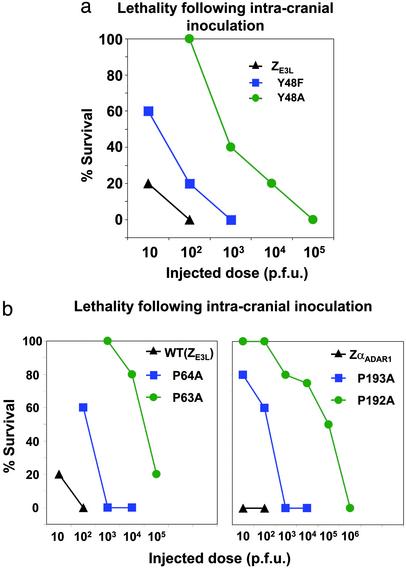Fig. 4.
A comparison of the in vivo pathogenic effects of analogous mutations in the Z-DNA-binding domains of ZαADAR1-E3LC chimeric and wild-type E3L vaccinia virus. (a) Experiments analogous to Fig. 3a were carried out on the E3L gene of wild-type vaccinia virus. Dose–response curves are shown of the lethality after intracranial inoculation, monitored for 2 weeks, for different doses of the virus. Results are shown for virus containing wild-type E3L and for virus containing Y48F or Y48A mutations. The results are similar to those shown in Fig. 3a for the ZαADAR1-E3Lc chimeric virus. (b) Comparison of the effect of mutations in analogous proline residues of the E3L gene in wild-type vaccinia virus, as well as the ZαADAR1-E3LC chimeric virus. (Left) Mice were infected intracranially with the indicated doses of wild-type vaccinia virus [WT (ZE3L)], or with vaccinia virus containing P63A or P64A mutations. (Right) Mice were infected with virus containing chimeric (ZαADAR1-E3LC) or the chimeric virus containing P192A or P193A mutations. The P64A mutation in the wild-type E3L gene produces decreased virulence in a manner similar to that seen with the P193A mutation of ZαADAR1-E3LC chimeric virus, with an LD50 of ≈102 pfu. The P63A mutation in wild-type E3L or the P192A mutations in ZαADAR1-E3LC chimeric virus results in further weakening of the virus, with an LD50 of 104 to 105 pfu.

